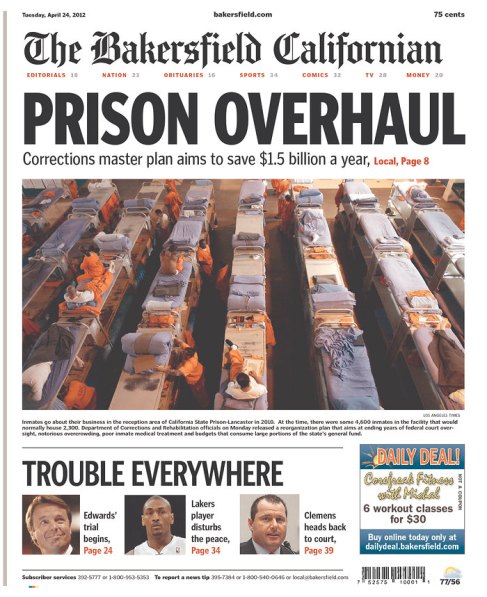Final critques
by Alysha Love
I’ve never thought much about what it would be like to design on a tabloid-sized paper; I’ve never had much need design-wise, and I never read tabloids. I found this page from the Bakersfield Californian on Newseum and found myself intrigued by it. It’s interesting how much information they’ve managed to cram onto the front page while still looking sleek, clean and spacious. They’ve even gotten an ad onto their small front without seeming to cost them anything very important. The nameplate is impressively full of information; it’s got the standard date, website and cost, but also prominently yet discreetly displays the index. They’re still able to play the photo for their centerpiece story big with headline, deck and photo caption. They’re betting that’s enough to get you to flip to the story start; that could be a gamble, depending on how engaging the content is. I like the package at the bottom that groups the other three stories together to tease into the paper. I do think that would be a challenge to write every night, especially if the stories needed some kind of link like “Trouble everywhere” to latch them together. Searching for similar content in the paper instead of the most important news could cause the front page to not hold the most relevant content for the readers. It would also be difficult to write such short refers for the stories. Overall, although the design is efficient and looks nice, I don’t think that it’s a good service for the readers when every element on the page sends you digging into the paper with very little information to go on.
I have no idea what the context for this page is aside from the fact that it’s a McDonald’s advertisement. None of the stories are about McDonald’s or anything to do with food. From what I can tell, this is a regular page that was mostly deprived of art to create what would otherwise be a text-heavy, gray page. All it took to create the advertisement was adding color to the columns with a bit of darker color for shading. The fry container at the bottom of the page gives the necessary context to make the ad clear. I love, too, that McDonald’s knows that all it needs is the tips of the arches to let everyone know that these aren’t just any fries; they’re McDonald’s fries. From the advertiser’s perspective, this is a brilliant idea to play off of the format of the newspaper in such a creative way. It’s a nearly full-page ad that’s attention-grabbing and clever. The design itself is simple to execute. However, I’m iffy on this from an editorial standpoint if all that text is indeed continued from the stories at the top of the page. On one hand, it’s awesome to be able to double up on space — to sell a 2/3 page ad but still be able to fill most of that with editorial content. On the other hand, it would feel very wrong to lend large chunks of text to an advertisement. It seems that it would be most appropriate with wire content that isn’t serious in nature but would be very wrong with local content of any consequence. Even if it were wire copy, such an intricate combination of editorial and advertising is a bit unsettling. I would like this design concept more if the page were part of a story the newspaper put together about fast food or unhealthy eating habits. Overall though, I love this concept and its execution here.







 I love this H because it combines the plain and whimsical; the heavy stroke of the capital beautifully contrasts the light stroke of the lowercase letter. It’s clean but engaging.
I love this H because it combines the plain and whimsical; the heavy stroke of the capital beautifully contrasts the light stroke of the lowercase letter. It’s clean but engaging. I love how happy this “Q” is. Again, it’s simple, but it’s also fun without being over-the-top or annoyingly cutesy.
I love how happy this “Q” is. Again, it’s simple, but it’s also fun without being over-the-top or annoyingly cutesy.  We’re publishing a panorama on Friday about how kids aren’t able to write cursive anymore. This would be a pretty good art drop head idea to accompany a story like that.
We’re publishing a panorama on Friday about how kids aren’t able to write cursive anymore. This would be a pretty good art drop head idea to accompany a story like that.  I like how round this “E” is — very bubbly. It’s also visually intriguing; the white strip on the inside can play tricks on your eyes. The bold color and simplicity (no pattern to the color) make it a striking character.
I like how round this “E” is — very bubbly. It’s also visually intriguing; the white strip on the inside can play tricks on your eyes. The bold color and simplicity (no pattern to the color) make it a striking character. I just love this. WHO wouldn’t?
I just love this. WHO wouldn’t?